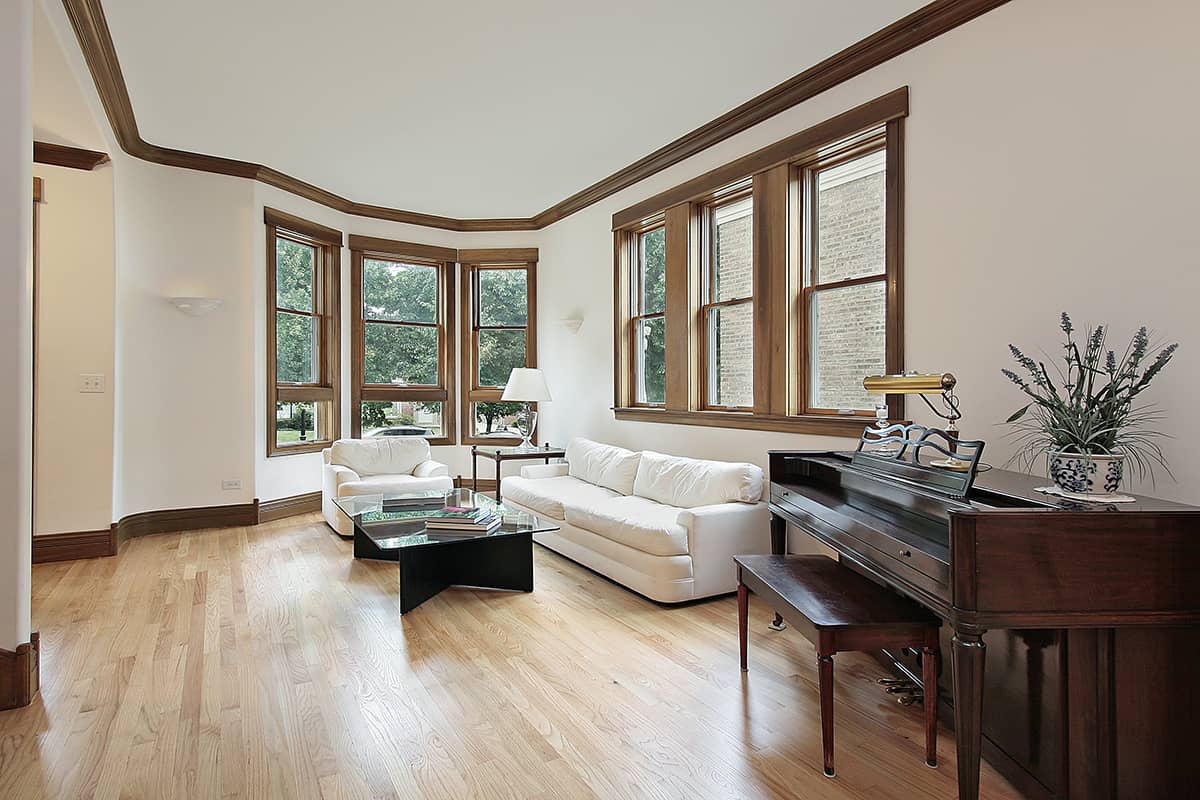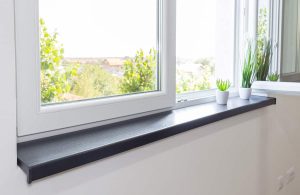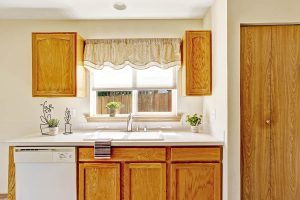Just like your home’s decor and furniture, blinds are an essential decorative and functional element of an interior. Not only do they control light and ventilation, but blinds also give us much-needed privacy.
Since these window coverings have a shorter length than curtains, they don’t get as dirty, thus making them a much healthier option as window treatments. When you’re pairing blinds with wooden window frames, deciding on the right color can be challenging.
With so many blind styles, colors, and materials to choose from, it can be quite confusing to coordinate a cohesive design that works with your window frames. So what color blinds go with brown wooden window frames? Here are some suggestions:
- Brown faux wood blinds to match the window trim
- Bamboo blinds
- White and other neutral colors
- Navy fabric blinds
With that in mind, let’s discuss our ideas in more detail…
Best Blind Colors that Go with Brown Wood Window Trim
Brown Faux Wood or Real Wood
A matching wood blind to the brown window trim is a fail-safe strategy that many homeowners opt for. Since your window trim is light or dark brown, you can’t go wrong with a brown wood blind in a lighter or darker shade. This color match won’t clash and still keep your windows the focal point of the room. The classic combination of brown is a timeless look in any interior style.
Brown wood blinds also look great with brown hardwood flooring. For a monochromatic feel, pair your brown wooden blinds with wood furniture and flooring. On the other hand, if you opt for faux brown blinds, be sure to match them with your fixtures or furnishing color.
Bamboo
Bamboo is another natural blind material that looks beautiful on brown wood window trim. This material is made into thin, long tubes to create beautiful window coverings. There are numerous bamboo blind colors that go nicely with brown window trim, including gray, light or dark brown, beige and tan.
These roll-up blinds provide adequate privacy and protect the room from UV rays. Bamboo blinds can also enhance a room’s dimension, especially if you pick a light color. In fact, these blinds function exactly the same as traditional upholstered blinds.
In boho-inspired or contemporary interiors, bamboo blinds on brown wood window trim are the ultimate eye-catching element. These types of blinds are easy to clean, affordable, quick to install and maintain.
Neutrals
Neutral blind colors like beige, tan, gray, cream and white all go well with brown wood window frames. This option will help make your windows stand out as the neutral blind serves as a backdrop. For those who are after a minimalist design, neutral blinds in any material is a stylish choice. These muted colors allow you to combine brighter patterns in the form of wallpaper or wall color for a more exciting ambiance.
Since neutral blinds won’t clash with other colors, you won’t have to worry about replacing them should you decide to change your wall, furniture or decor color in the future. Choosing such colors for your blind tends to soften the window covering without drawing the eye to them. By opting for neutral blind colors, you can create the illusion of space. This makes these blinds perfect for small or narrow rooms.
Bold Blue
For added warmth and brightness, go for dark blue blinds. These window dressings will accent the brown wood window trim as well as accentuate the rest of the room’s decor. A rich blue blind brings depth and visual interest, so whether you go for admiral, turquoise or navy, it’s guaranteed to look super cool on your wooden window frames.
A dark shade of blue like navy offers excellent privacy and light protection, so it is a great option for home theaters, living rooms and bedrooms. In large, open-plan layouts with white walls, a bold blue blind won’t darken the space or feel overwhelming.
Should Blinds Match Window Trim?
Not necessarily. While the safest way is to match your blinds with the window trim, this design decision won’t make your window treatment stand out. But rather, it will be your window trim that shines instead. A more effective option is to match your blinds with the floor or wall color.
Alternatively, you may slightly match your blinds with your window trim by choosing a shade lighter or darker. If your window trim is light brown, for example, dark brown wood blinds can stand out. What’s more, the window treatment won’t darken your room as long as the walls behind it aren’t painted in a dark hue.
Which is Better: Faux Wood or Natural Wood Blinds?
There are pros and cons with both faux and real wood blinds so the ultimate decision lies in your own circumstances and preference. Faux wood or PVC blinds can withstand high humidity or moisture, thus making them a better choice for bathrooms and kitchens. These types of blinds won’t crack or warp over time when exposed to high moisture.
In fact, they make a more durable option than real wood blinds purely because of their ability to remain in good condition for longer plus are more cost efficient.
Another advantage to faux wood blinds is their resistance to fading as they’re constructed with high-quality UVA resistant polymer materials.
When it comes to cleaning blinds, faux wood fares better than natural wood blind. Real wood isn’t waterproof and doesn’t like moisture so cleaning the wood blind with a damp cloth isn’t advisable.
Instead, you’ll need a duster to remove the dirt and debris without the material coming into contact with water. Try to keep the blind as dry as possible, plus avoid hanging your real wood blinds in the kitchen and bathrooms, where they are susceptible to moisture and humidity.
While real wood blinds don’t make a great choice for high humidity rooms, there is no reason why you couldn’t use them in your bedrooms, living room or dining room. Custom-made wood blinds are an attractive design for such rooms, especially in rustic style interiors.
Other factors that make real wood blinds a more appealing option include their aesthetic beauty. What’s more elegant than hanging natural wood blinds in a luxury living room or bedroom. This chic choice dresses up your window, plus it’s easier to hang thanks to the lightweight feel of the material.
A natural wood blind is an eco-friendly alternative to PVC or faux wood window treatment, so if you care about the environment, real wood is a better option.
In addition, just like faux wood blinds, wood is a naturally insulating material that offers excellent protection against UV rays. It helps retain the heat inside your home in winter. Faux blinds also boast a high level of insulation and are still considered as energy efficient window coverings.
The style of your interior and your personal taste will ultimately influence your decision on whether you go for faux wood or real wood blinds. Bear in mind that natural wood blinds are more expensive than PVC or faux wood, plus they are not as easy to clean as their plastic counterparts.
Final Thoughts
Finding the right blind color for your brown wood window trim can be tricky as you also need to take into account the room’s other furnishings and elements. In case you’re still uncertain, just opt for neutrals, such as beige, tan or white blinds.
Your interior’s function plays an important role in the blind color you choose. For instance, a living room with brown window trim can benefit from navy blinds, while a formal master bedroom can be dressed with a matching brown wood blind to tie the look together.
In a dining room, the window trim can be decorated with white or gray blinds for a modern feel. If you like a bolder color pairing, opt for a contrasting color to your brown window trim. Navy blue is one such color that makes a powerful impact in a kitchen or bedroom.
But aside from the blind color you choose for your brown wood window trim, the material itself can change the feel of the interior. Faux and real wood blinds look very similar to one another, but they have different traits that make them suitable for different settings. If you’re on a tight budget, faux wood blinds offer a cost-efficient choice, with a range of textures and colors available.
For a more formal and luxurious interior design, real wood blind has enhancing insulation properties as well as adds texture and depth to your wood window frames.
There are also bamboo blinds that can enhance the appeal of brown wooden window frames. Whichever material you choose for your interiors, be sure to select the right blind color based on your furnishings, wall and floor colors for a coordinated look.










